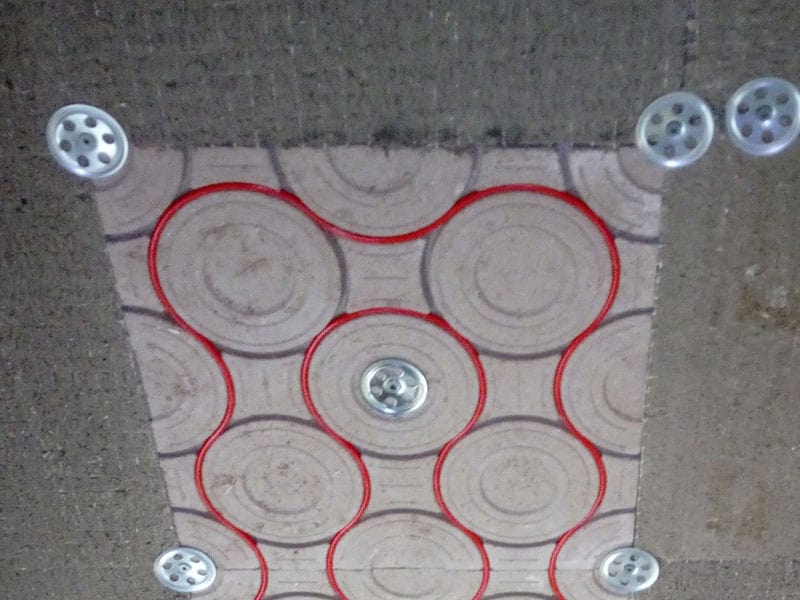Natural heating and
cooling using clay-based
ceiling mounted panels
About us
Our goal is to achieve maximum energetic self-sufficiency for both residential and commercial buildings by employing the latest sustainable renewable energy sources, heating and cooling systems. Our main focus hereby lies in using photovoltaic power to directly power the building’s heating and/or cooling systems, without the need of any external energy input – be it oil, gas or electricity. In fact our solutions will provide more energy than the building itself requires, thus allowing feeding surplus power to the public energy grid. This not only allows for a more decentralised power infrastructure, but reduces our carbon footprint to the absolute minimum possible, whilst saving you money otherwise spent on energy at the same time.


The high density of clay makes it an ideal medium to store energy. A room can be heated or cooled to a desired temperature, once this temperature is reached very little energy is required to maintain it due to the thermal inertia of clay.

Clay has the natural ability to absorb, store and release moisture depending on the relative humidity of the air. It self-regulates the relative moisture to 50%, if the air in a room has a higher humidity the surplus moisture is absorbed.

Clay is a completely natural product. Production, use and disposal release no environmentally harmful substances.

Clay is also a natural absorbent of odors, adding further to the air quality in rooms.
How the system works

Like with most common heating systems, water is used as the primary energy carrier. However, we use exactly the same system for active cooling as well! This makes it a lot more efficient than air based AC systems, as one litre of water can store/transport the same amount of energy as 3300 litres of air. Thus we have an all in one system, that provides both heating and cooling depending on requirement.
This image shows the raw installation of the ceiling to be heated or cooled. Modular clay plates are screwed to the ceiling and a flexible pipe which will carry the water is run through the matching grooves.
Installing the system on the ceiling may at first seem counter intuitive to most people (especially when heating as warm air always rises, right?), but it provides several advantages:
– In heating mode, the sole heat source for any object in the room is radiant heat, similar to how the sun’s heat reaches us here on earth. This makes it a lot more efficient than heating the floor, as there is almost no thermal convection in the room (2%) and almost only radiant heat (98%). An isothermal state of all objects as well as the air in the room can thus be achieved with much less total energy input (~30%) as unwanted thermal convection is eliminated within the room.
– In cooling mode the physics are reversed, and we actually want the air in the room to gently mix to provide a comfortable climate. Other than conventional AC systems where you have a few air vents which blow uncomfortably cold and dry air into the room, you almost don’t notice the cooled clay ceiling in action. As a very large area is being cooled, warm air rises to the ceiling, cools off just slightly and gently sinks back down. The people in the room will only notice that the air is comfortably fresh, not too cold and not too dry. But they will find it impossible to locate the origin of the cold air as the entire process is so gentle compared to air based AC units. And again, the energy efficiency is also much higher, using a reversible heat pump it can even be close to 100%.
Setup of the clay ceiling
A thermally nonconductive base such as OSB is added to the ceiling, to which the modular clay plates are screwed. After the pipes are installed, they are covered with clay plaster and finished with either clay or chalk based paint.
The installation is possible on all types of ceilings. Concrete, wood, steel are all suitable, as long as the thermally nonconductive base layer can be added.
The maximum height of rooms is six meters for heating and nine meters for cooling. Higher is of course possible, but the efficiency as well as the room comfort will eventually decrease.

Providing the hot or cold water efficiently
The best means to provide either hot or cold water are electric air/water or water/water heat pumps.

Heating
Heating is currently the most common application for heat pumps. Energy is drawn from an external medium such as air or water from outside the building and added to the water of the heati ng system inside the building by using electric power. State of the art heat pumps have CoP values over 4, meaning that from each kWh of electric energy four kWh thermal energy can be produced. Coupled with a photovoltaic system it is not difficult to heat even large commercial buildings very efficiently, often even with an energy surplus.
Active Cooling
For active cooling we again reverse the roles, this time quite literally: Instead of drawing energy from an external medium, we reverse the heat pump to draw energy from the water running through the ceiling. This way we now actively cool, and instead of just venting it outside like most common AC units do, we can now use this energy to heat something else inside our building, for example the water for the bathrooms.
As with heating the ideal source for the electricity is a photovoltaic system, as we have sunlight in abundance in hot climates. Fully energy self-sufficient and very comfortable buildings, no matter their size, can thus be very easily achieved.

Album
Contact
BILIB GmbH
Krantorweg 48c
13503 Berlin
Tel.: +49(0)30 81309085
Fax: +49(0)30 81309086
E-Mail: info[at]bilib.de











